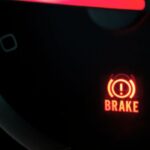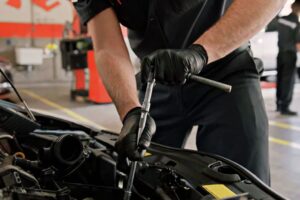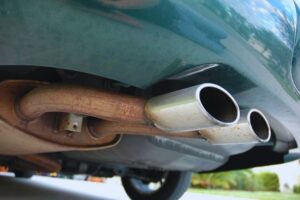Have you been in a situation wherein you feel the brake pedal sink to the floor while driving down the highway? This can be a pretty harrowing and alarming experience. If you haven’t experienced it yet, it would be best to be fully prepared when this scenario happens. So what should you do if your brake pedal suddenly sinks to the floor and your brakes don’t engage?
If your brake pedal feels spongy and you get to push it to the floor, there could be several causes. However, if it does happen to you, here are the things you need to do:
- Don’t panic
- Pump the brakes
- Engine brake
- Engage emergency brake
Hopefully, you will be able to safely stop your vehicle and have it fixed as soon as you can.
Read on to learn more about what to do if your brake pedal suddenly sinks to the floor and a few fixes.
What to Do If Your Brake Pedal Suddenly Sinks to the Floor?

The scariest thing that any driver might experience while on the road is suddenly losing the use of the brakes. Suddenly losing the brakes is not impossible.
It is not even that rare, so it is always a possibility. You must mentally prepare yourself for when this happens. If your brakes suddenly give out on you while you are driving, here is what you need to do:
1. Don’t Panic
When your brakes suddenly stop working while driving, the most important thing to remember is to avoid panicking. You need to keep a cool head to know what you need to do next.
Panicking won’t help at all. It may even cause you to start weaving through the lanes, which you must avoid. Keep calm and hold the wheel as straight as you can.
2. Pump the Brake
Take your feet off the gas and start slowly pumping the brake pedal. Sometimes, an air bubble gets into the brake lines, causing sponginess. Pumping the pedal will get the brake fluid into the master cylinder again. This will let it work properly again.
Pump the brakes a couple of times gradually. Avoid doing it frantically. If you do it too fast and the brake fluid goes to the brake cylinder, the wheels may get locked. This will further lead to your car fishtailing and even spinning out of control.
3. Engine Brake
If your brake pedal does not work even after pumping the pedal, you can slow down using engine braking. To use the engine brake, shift the gear down to make the engine slow down the car.
If you are driving a manual transmission, gradually go down the gears until you stop the car. If you are driving an automatic, shift down to D2 and then to L. Hold the wheel steady until the car stops.
The engine brake works by using the transmission to slow down the driveshaft, slowing down the wheels. It is important to shift down gradually. Avoid suddenly shifting to first gear while the car is still moving fast. Doing so will only wreck the transmission.
4. Engage the Emergency Brake
Now, let’s say that the engine brake is not slowing the car fast enough. Also, pumping the brake pedal is not doing anything. What should you do then?
Your last resort is to engage the emergency brake. Be careful when doing this because it will cause the rear wheels to lock. This may result in your car fishtailing out of control.
If your only resort is to use the emergency brake, hold the steering wheel steady with one hand. Take your foot off the gas and then gradually pull on the brake lever.
Also, ensure that you are flashing your warning lights to alert the other vehicles on the road. If you manage to pull this maneuver off, your car will skid to a halt.
It should stop your car successfully and, hopefully, park it on the shoulder of the road where it is safe. If you are successful in doing that, call a towing service to help you get out of there.
If a police officer responds to your situation, you will also be getting towing assistance. Have your car immediately checked by a certified mechanic so that this will not happen again anytime soon.
Causes of Spongy Brakes
Spongy brakes refer to a situation when the brake pedal quickly sinks to the car’s floor. This happens due to a couple of different reasons, including the following:
1. Air in the Brake Lines
The only thing that should be in your brake lines is brake fluid. If an air bubble gets into the brake system, it can cause a spongy brake pedal.
You can usually fix this problem by bleeding the brakes. Ask your mechanic to do it for you if you can’t do it. Another likely cause for this is if you recently had some work done on your brakes.
Have you bled the brake line already, but the pedal still got spongy later? Then there might be a leak somewhere in your brake system.
2. Damaged Brake Lines
Although other components in the brake system may have gotten damaged, it most usually happens to the brake lines. The brake lines may even have accumulated rust, resulting in their damage. This is common when living in a coastal area with salt on the roads and the breeze.
The broken brake lines will not just leak brake fluid if left unattended. It will also let in air bubbles that make the brake pedal spongy.
3. Oil Brake Fluid
Although brake fluid tends to last quite a long, it does not last forever. Some brake fluid manufacturers set a lifespan of 20,000 to 30,000 miles on their products. However, it is not quite as simple as that.
Brake fluid can last up to 100,000 miles. This is without leaks in the brake line that may cause air to get inside the system. Once air gets into the brake lines, the brake fluid may oxidize. This can further lead to the fluid going bad quicker.
If your brakes even feel remotely spongy, have them checked out by a mechanic. Have your brake system flushed and put in new brake fluid.
4. Brake Booster Leak
The brake booster is yet another critical component of the braking system. Its purpose is to amplify your foot’s force when pushing on the brake pedal. This works through the wonders of hydraulics. If any of the rubber seals in the booster start to fail, it can’t do its job at all.
5. Faulty Brake Master Cylinder
The brake master cylinder’s job is to provide equal fluid pressure on the brakes. This part needs to have a lot of rubber seals and gaskets. The main reason is that it handles all the brake fluid.
If any of the many seals in the master cylinder breaks, the air may get into the brake lines. This will result in spongy brakes. In addition, air can also get through the cap of a broken brake fluid reservoir.
6. Damaged Brake Calipers
The brake calipers are also common culprits for spongy brakes. The caliper pistons have seals that prevent the brake fluid from getting out when they extend. However, they would leak after a while, causing air to get into the brake lines. This can make the brake pedal spongy.
Damaged brake calipers can also result in the brake pads and rotors getting covered in brake fluid. The brake fluid will make the rotor slick, causing difficulty grasping the caliper.
Again, what to do if your brake pedal suddenly sinks to the floor? If your brake pedal suddenly sinks to the floor, you should shift to a lower gear. Then, pump your brake pedal. This way, there will be a pressure buildup enough to stop your vehicle. Ensure that you place your car in a safe place.
Why Do My Brakes Squeak When I Release the Brake Pedal?
Brake Maintenance Tips
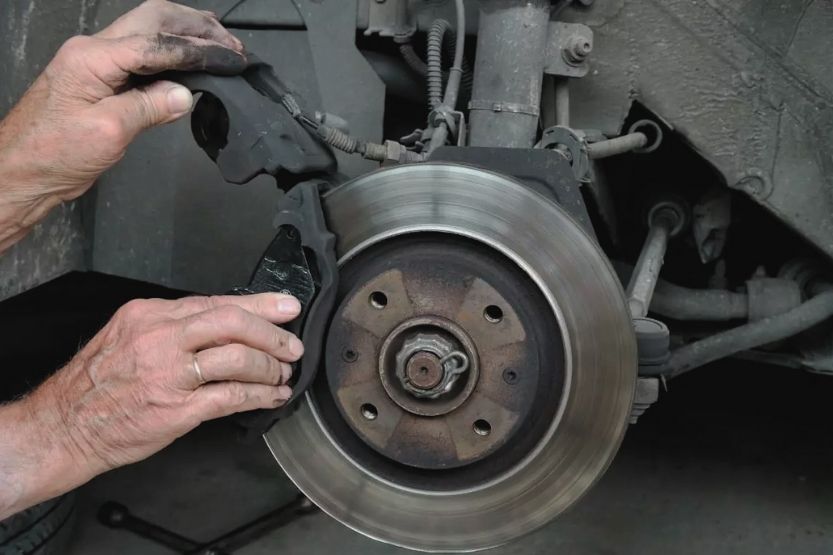
The brake system may be quite complex, but you will be surprised at how easy it is to maintain it. You can even do it yourself:
1. Check All the Important Components
Because of its importance, you will need to check and maintain your brakes regularly. Check if all the important components are in good working condition. The parts you should focus on include the following:
- Brake caliper,
- Rotor,
- Brake lines,
- Master cylinder,
- Brake pads, etc.
How Long Does it Take to Replace Brakes and Rotors?
2. Check the Car’s Manual for Any Recommendations Regarding Brake Maintenance
Also, check your car’s manual for any recommendations regarding brake maintenance. More likely than not, the manual will have information about the recommended brake system maintenance schedule. If you misplaced the user manual, here are key tips to determine if your brakes are still safe.
3. Regularly Check the Brake Pads and Rotors
The brake pads and rotors are the main workhorses in the braking system since they touch the brakes and the wheels. These parts produce extreme amounts of friction and heat when working.
This is why they are also the first ones to deteriorate. It is important to check the brake pads periodically to see if they are still thick enough. Replace them before the lining wears down and the metal is already exposed.
If you feel the need to press the brake pedal harder than before, it may indicate worn-down brake pads. Another sign of worn-down brake pads is if you hear metal scraping against metal when you brake.
Further use will result in extensive damage to the brake rotors. These components are much more expensive to replace compared to the brake pads.
4. Flush the Brake Fluid
The braking system is essentially hydraulic, and the fluid that makes the components work is the brake fluid. The master cylinder may push brake fluid into the brake caliper pistons when you step on the brake pedal. This causes them to push the brake pad onto the rotor.
However, brake fluid can also go bad after a while. If enough outside moisture contaminates the brake fluid, it can lead to serious corrosion of the metal components. Ideally, you will need to get the brake fluid flushed out of the system.
Replace it with a fresh batch every 25,000 miles or based on the manufacturer’s recommendations. One way to tell if your brake fluid needs replacement is if it already looks cloudy or milky.
5. Bleed the Brake Lines Periodically
The brake system is not perfectly sealed. Even times, air bubbles tend to get trapped in the brake lines.
Having enough air in the brake lines causes a void, momentarily leading to the brake pedal sinking into the floor. You will need to pump the pedal a few times to make the master cylinder pump brake fluid again.
To get rid of the trapped air, you will need to bleed the brake lines. This means opening the bleeder valve, usually on the brake caliper. Pump the brakes until the brake fluid comes out.
You do not necessarily have to do this personally. The reason is that it often only happens during your car’s scheduled periodic maintenance service.
6. Replace or Upgrade the Brake Parts
Have you been driving your car for a while now, like ten years or so? It might be time to replace the worn-down parts of the brake system already. Also, since you are already replacing them, you might as well get upgraded versions.
For instance, you can replace the original brake rotors with slotted ones that better dissipate heat. If you don’t have that big-budget, start by using ceramic brake pads.
They last longer than the conventional brake pads. Also, they produce significantly less dust, which means minor damage done to the rotors.
Proper Braking Techniques to Extend the Life of Your Brakes
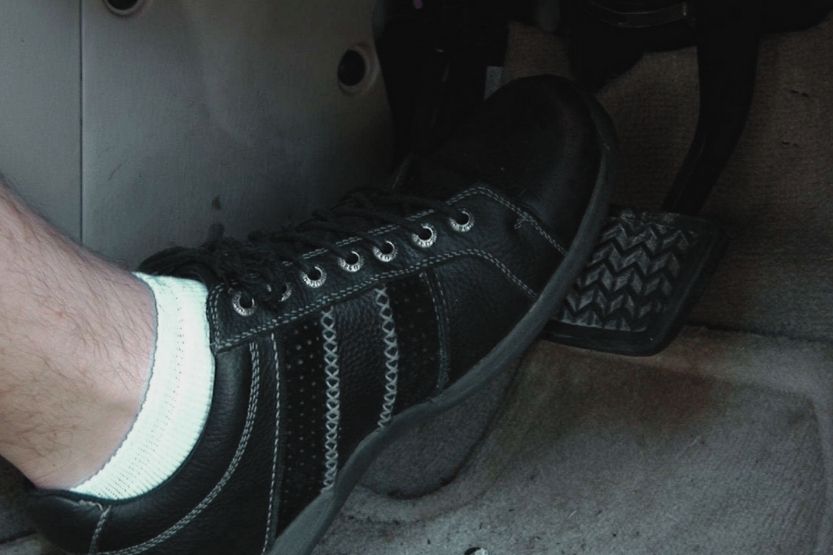
You can also extend the life of your brakes with the help of the following techniques:
1. Avoid Using the Brake Too Much
Some people have this bad habit of using their brakes too often. They would use them by now to the extent that the brake pedal goes to the floor, but there are no leaks. If you are following the speed limits, there is no need for you to step on the brakes.
Do it only when stopping at a traffic light or if you need to stop the car. When you are driving and want to slow down, you can take your foot off the gas. This will be more than enough to slow down.
In addition, break your bad and dangerous habit of tailgating the vehicle in front of you. Give plenty of room between you and the vehicle in front.
If the driver decides to slam on the brakes, this will give you more than enough space. Having more than enough space between you and the car in front greatly reduces the likelihood of a rear-end collision.
2. Anticipate When It Is Ideal to Brake
Stop stepping on the brakes abruptly, as it will only put unnecessary wear and tear on the brake pads. Anticipate when you need to brake. You can only do this when you are traveling within the speed limits.
Focus on the road ahead. If you notice that the traffic in front started to slow down, do not feather the brakes. You have to take your feet off the accelerator.
The engine will be the one that will be slowing the wheels down. Press on the brakes only if you notice that your vehicle is not decelerating fast enough.
3. Never Brake Into a Turn
Do not speed up if you know that you will be turning at the next corner. Apply the brakes only as you make the turn. It is much safer to put yourself in the outermost lane well before you need to turn. After that, just coast towards and into the corner.
4. Don’t Ride the Brakes Downhill
You should never ride your brakes down when going down a mountain road. It should form part of your list of what to do if your brake pedal suddenly sinks to the floor.
This will cause the caliper and rotor to heat up too much, making the brake pads wear out faster. It can also cause the rotor to warp out of shape.
Just put the car into a low gear so the engine and transmission would slow down the car sufficiently. You do not also have to step on the brakes.
Frequently Asked Questions (FAQs)
Can I Drive with Worn Brake Pads?
Technically, you can still drive your car even when the brake pads have worn down considerably. However, it is highly advisable not to do that.
This does not only mean that the brakes will not work quite as well as they used to. The metal-against-metal contact can seriously damage the brake rotor, too.
Is Brake Fluid and Clutch Fluid the Same?
It depends on the brand. There are some popular brands where brake fluid also works as clutch fluid for manual transmission cars. However, some higher-end brands have separate products for brakes and clutch.
Conclusion – What to Do If Your Brake Pedal Sinks to the Floor
If your brake pedal suddenly feels spongy to the extent that you can push it into the floor, several issues may cause it. Here are some tips that can help you properly stop if it happens to you:
- Don’t panic
- Pump the brakes
- Engine brake
- Engage emergency brake
Hopefully, you can stop your car correctly using the terms mentioned above, and when it does, you will be prepared.
Read next:

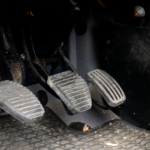


![Honda Brake Fluid [What You Need to Know] Honda Brake Fluid](https://roadsumo.com/wp-content/uploads/2022/02/Honda-brake-fluid-150x150.jpg)
![Electric Parking Brake Problems [Causes and How to Fix] electric parking brake problems](https://roadsumo.com/wp-content/uploads/2022/05/electric-parking-brake-problems-150x150.jpg)
